Theo Verelst Local Diary Page 99
This page is copyrighted by me, and may be read and transferred by any
means only as a whole and including the references to me. I
guess that's normal, the writer can chose that of course.
Aug 28, 02:57, 2010
(Most large images can clicked for a bigger version)
(page is in builtup)
The Duke heritage
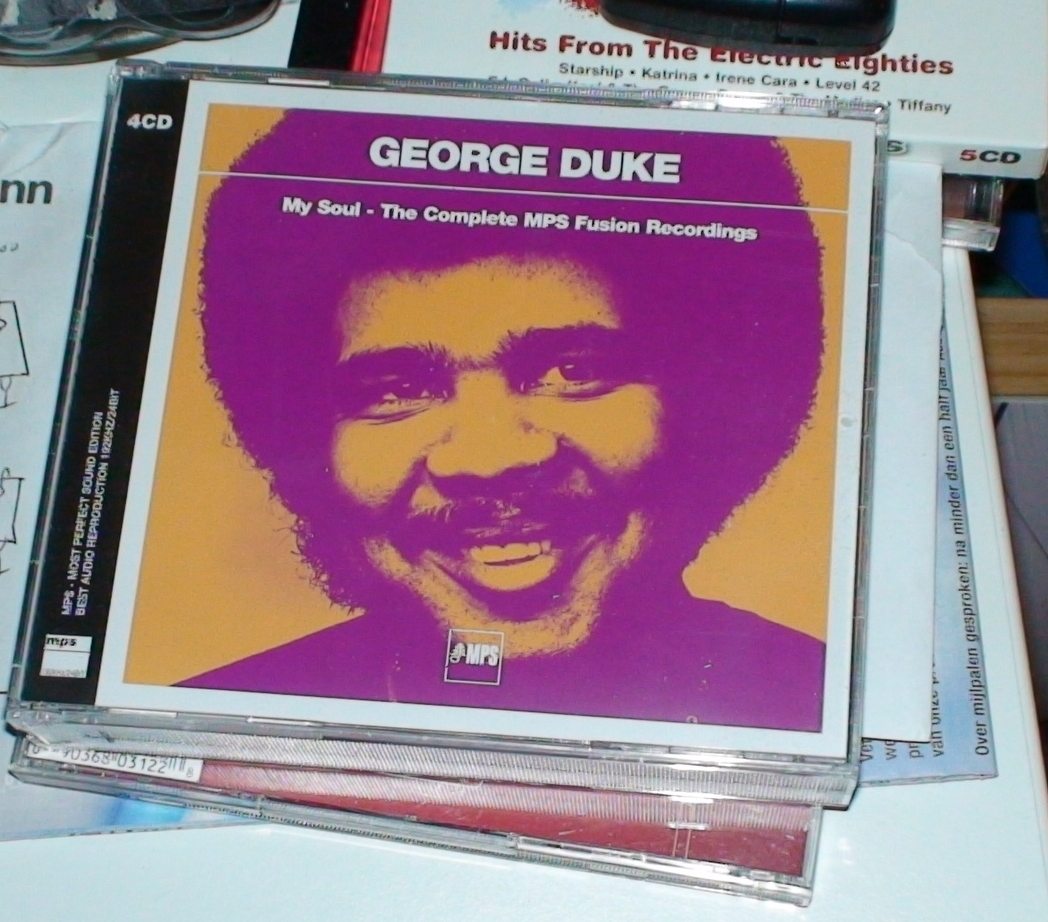
I got 4 CDs from LA (that sounds interesting, ordered from his site..)
with 6 ot 7 of the George Duke 70s funky albums on them, digitally
remastered in 24 bit, and am very glad with them.
I used to be somewhat of a Duke fan (how many keyboard-synth-piano
player who advanced the Funk are there anyhow!) back in the end 80s,
when I was practicing for bands and Jazz, and I´m sure he
influenced me and others to play decent, and good, and search for the
right synthetic sounds instead of a synthetic pointless endless sea of
meaninglessness and to honour the better (Jazz) session player rules.
These CDs aren´t as "clean" as some 24 bit Cheskey/HDTracks
recordings I can use as reference, and not the same style as quite a
few neutrally mastered popular CDs from over the years I use, but
interesting and alive, very well sounding, but I think either the
format or the remastering studio limits do not do total justice to the
great 70s sound as I think of it, even though the sound is interesting
and full.
Every self respecting funk pianist cannot afford not to know some Duke,
but this is more than some, so I´ll go over the songs a few more
times before feeling into that groove...
High Quality General Audio Monitoring
Urges to create flyers, mr. theover ? Not really except I could, my
system has been double checked lately because I can now use a good AKG
K271 mkII headphone set to compare my monitoring/HiFi/small PA ausio
system with.
And that come out great, they actually sound alike. That is
proposterous to say, I know, but true enough, though still being
further tested, which is of course a self-compliment, and great.
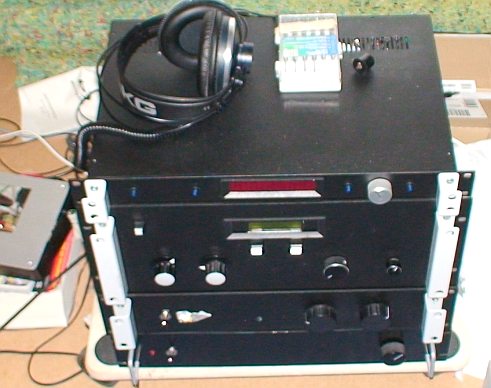
It´s mainly used with my preamp which can drive the headphones,
and has extremely good specs (distortion orders of magnitude less than
most equipment).
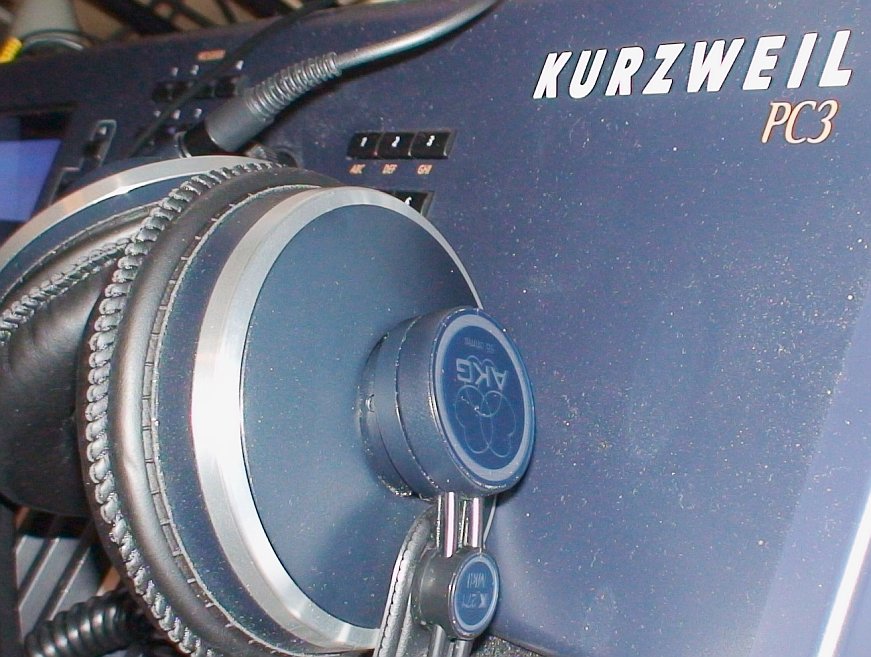
This machine I often (but not always) use as digital output machine,
being DA converted by the below Lexicon MX400, and then then preamped
to the headphones, with short low impedance wire.
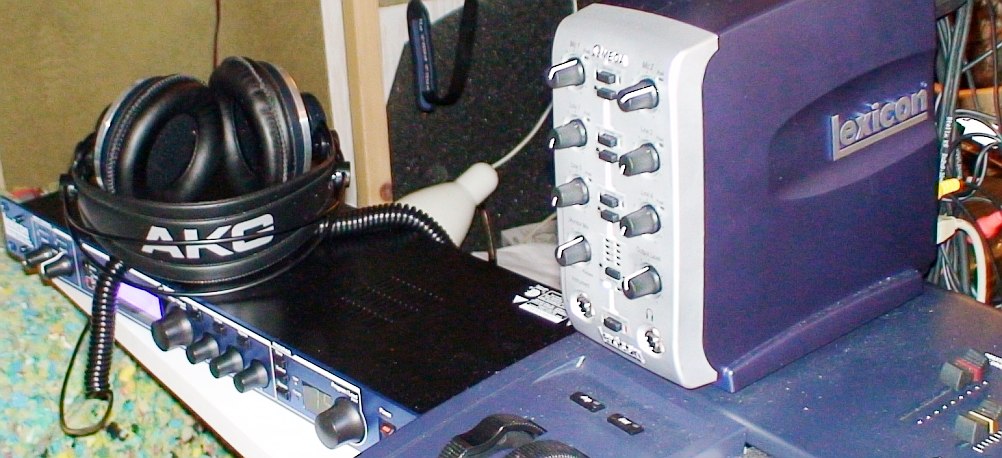
What a quality brand components, in a way that´s fun, because it
works.
Of course the headphones and speakers cannot just be randomly compared,
so I tested mainly the speakers listened to at the sweetspot, the well
known equal sided triangle, listening with the mid-high tweeter at
ear-hight. There more than some damping in the room, probably 2/3s of
walls and ceiling are damped, even though there are still clearly early
reflections, slight bass-buildups (but ever so not intruding) and of
course some remaining speaker corner bouncing waves, but still putting
on a disco or rock song (I didn´t try much jazz yet) and making
the volumes well comparible and the 3 frequency bands of the 5 way
monitoring system I built including the 15 inch sub (no bass-reflex
anywhere in the system) well balanced the not so probable is true
enough: the sounds are comparable, by and large over the while
frequency range.
The headphones also thusfar give nice effect impressions when added to
musical instruments or audio recordings, as of course they should.
Probably it´s a good idea to use a rumble filter (30 HZ or lower)
on them, because the bass end I think works neutral that way, and is
probably in the lowest range not comparable to whooping woofers of the
large kind, which is fine: under 20 Hz cutoff filter on is not bad for
the main monitoring either: many materials won´t do much work at
20 Hz anyhow, and most normal stereos and other systems get not much
volume done at that frequency anymore anyhow. I mean my sub can get a
serious few hundred watts (more peak, it may have up to 500W) when
needed to make only the lowest octave from 20Hz to 40Hz audible with
it´s large 15 inch cone and a damped enclosure of over a 100
liters. Most people will not be used to that idea. Yet for loud rock,
it might be the human hearing cannot be served at more than the
equivalent of mayb 110dB-loudness corrected...
15 way Multiband Audio Compression
Compression is the reduction of dynamic range that takes place on many
produced audio materials, and in the history of the modern music has
been one of the many used tools, also to create a certain atmosphere in
a production of track. Multiband compression is more advanced and does
the same dynamic reduction (soft sounds louder, and loud sounds
more moderate in comparison with uncompressed) but then with different
controls per frequency band.
Probably it should be considered usual to have some bands of
muticompression on the radio, and I know in PA systems 3 or 4 way
multiband limiting/compression occurs. Of course in these days fft
based effects can be used to make a bit different method of dynamic
range reducion (I experimented with Jamin, see previous pages which is
in fact good at that) but I prefer to not mess with the signal in that
way (add considerable harmonic and other distortion in spite of the
initially smooth sounding result, and also tends to get boring).
I thought I´d go for a bit more ambitious approach and try a 15
band compression signal path, which I made on Linux, on a not so new
but potent enough machine (3GHz Pentium D), using jack-rack as building
block.
I made 15 jack-racks with an equalizer followed by a stereo compressor,
where each of the 15 audio programs has only one frequency band slider
of the eq to 0 (no attenuation or amplification, and probably no
resonance centered at the band frequency), and all the other sliders to
-60 dB (1/1000th of the amplitude !). The compressors gradually have
faster settings for higher frequencies, and have mostly per
frequency band relative loudness related threshold and compression
factor settings.
All the 15 stereo filter+compression with 32 bit (floating point per
channel) audio processing rack units are connected up in parallel by an
automated startup shell script
(tcl) whic puts the connections in place, and also starts a 15 wide
meter bridge (left+right channel per frequency at the outputs of the
compressors), and creates a input and output rack with additional
effects, like so:
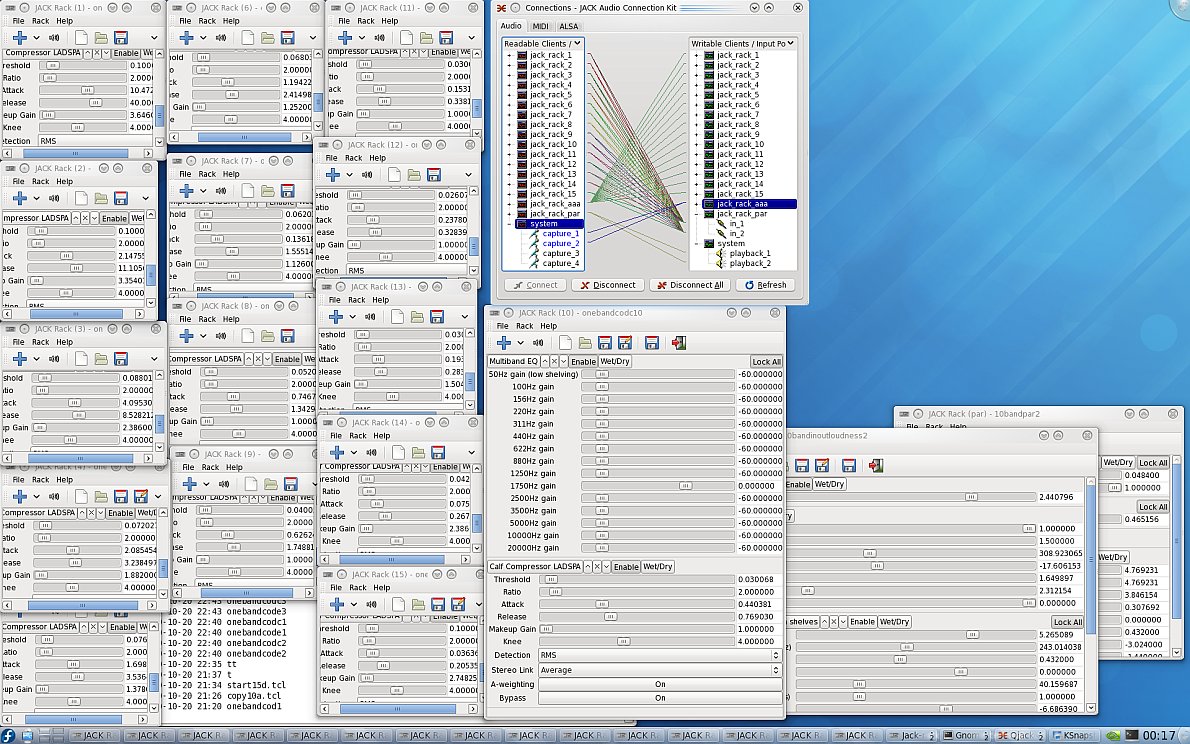
"system" is the computers audio IO.
For instance I used xmms (a sort of Linux winamp) with a good working
31 band eq to feed the whole mulitband compression chain, and also I
put the Lexicon MX400 in the loop, playing CD files on the whole:
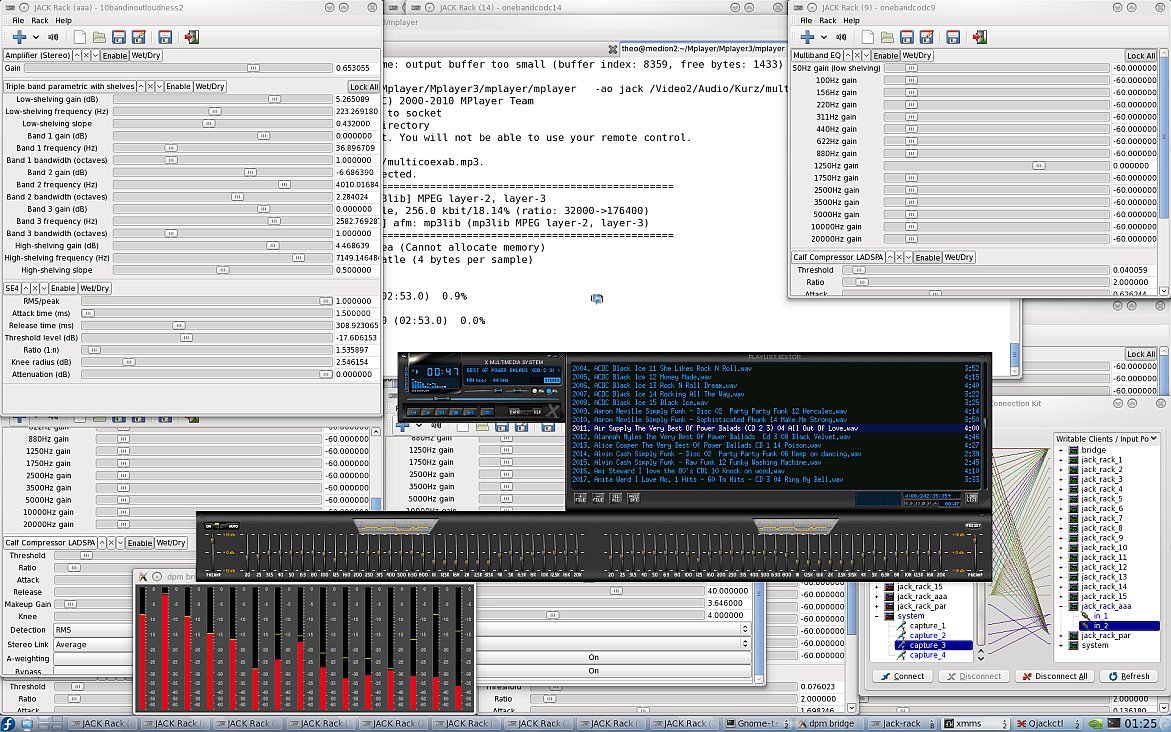
Works great to make the audio fuller sounding (even though of course a
lot fo CD might better be dynamically expanded instead of compressed,
which they already are..).
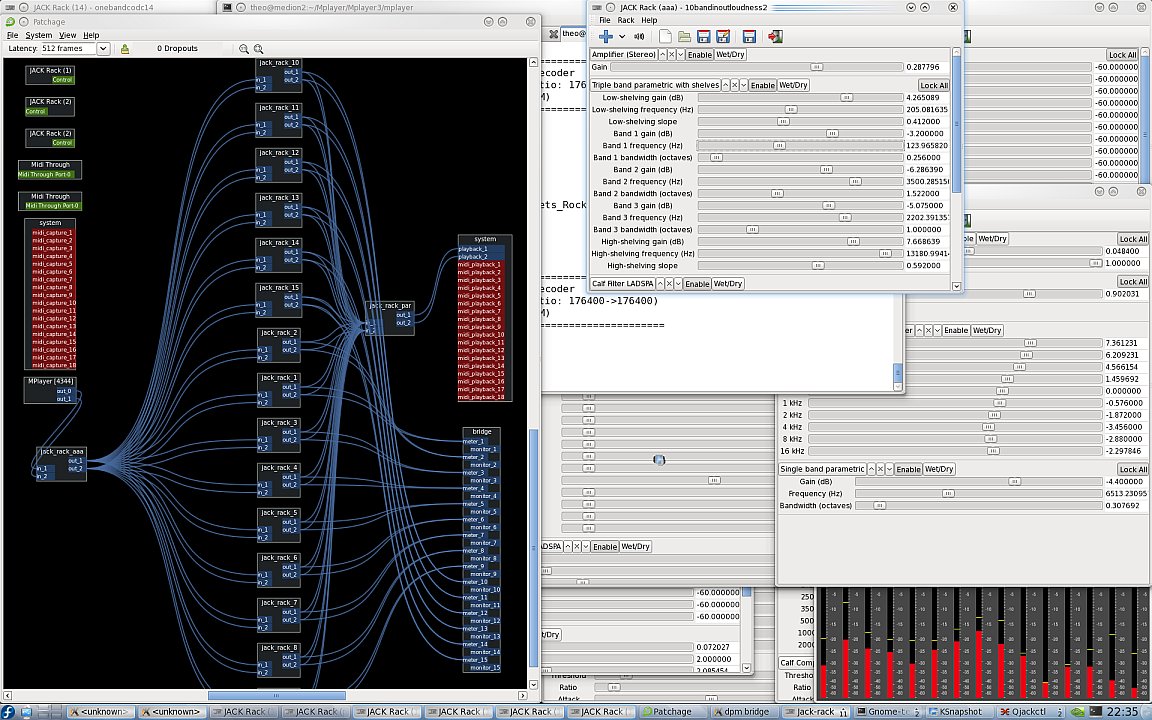
The above "ingenuity" application shows the graphical connections more
clearly.
I mades some test microphone recordings (with Audio Technica AT 2020s),
and synthesizer recording with somehow the above in the audio path (or
in the added effect path):
micmulti2.mp3
miltipc3tube3.mp3
In fact I´ve even made a mulitchannel compression-distortion
setup, with seperate tube sound effects per band, and the HD Sat
broadcast from Bon Jovi on the Itv I´ve enhanced and reverb-wise
un-killed bu using that and speaker simulations on certain bands...
Processor use ? Using the 15 band setup and "Calf" stereo compression
and additional non-linear effects takes about 50 percent of the
processors ability, on the centrino due 1.83 notbook I use with Linux
(and for the time fastest available 750 MHz FSbus), about the same,
without having to set the processor speed to maximum, and even
including some additional reverbs (not per band).
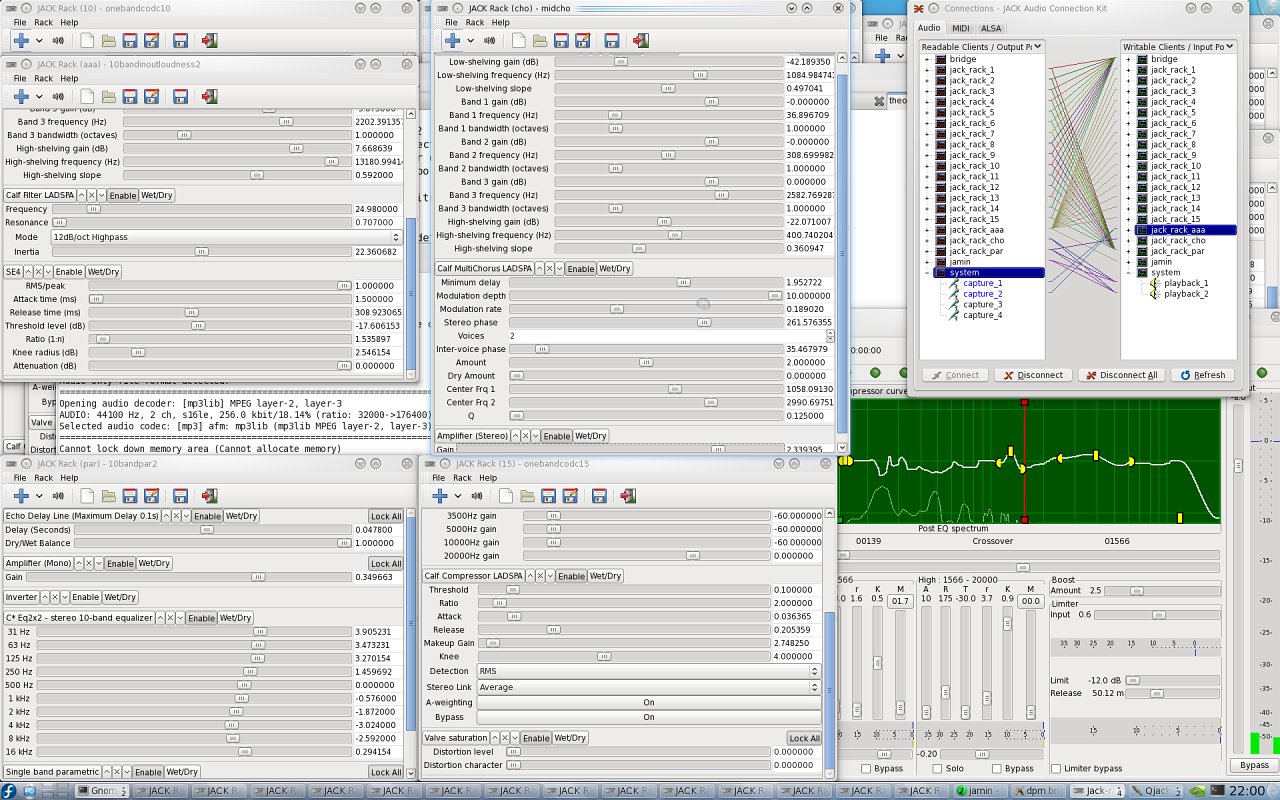
With many hundreds of slider controls, it can be handy to use
Xwindows´ multi screen feature (4 screens on a virtual turning
cube):
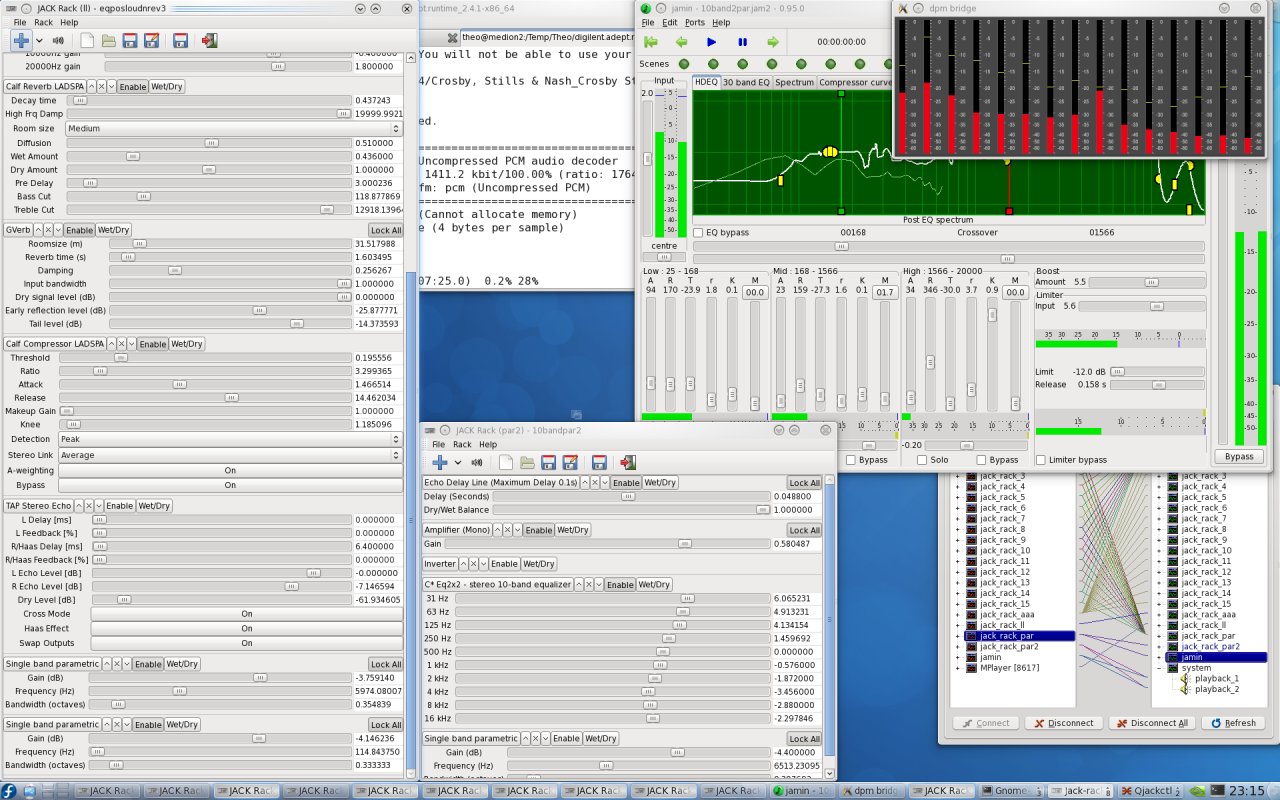
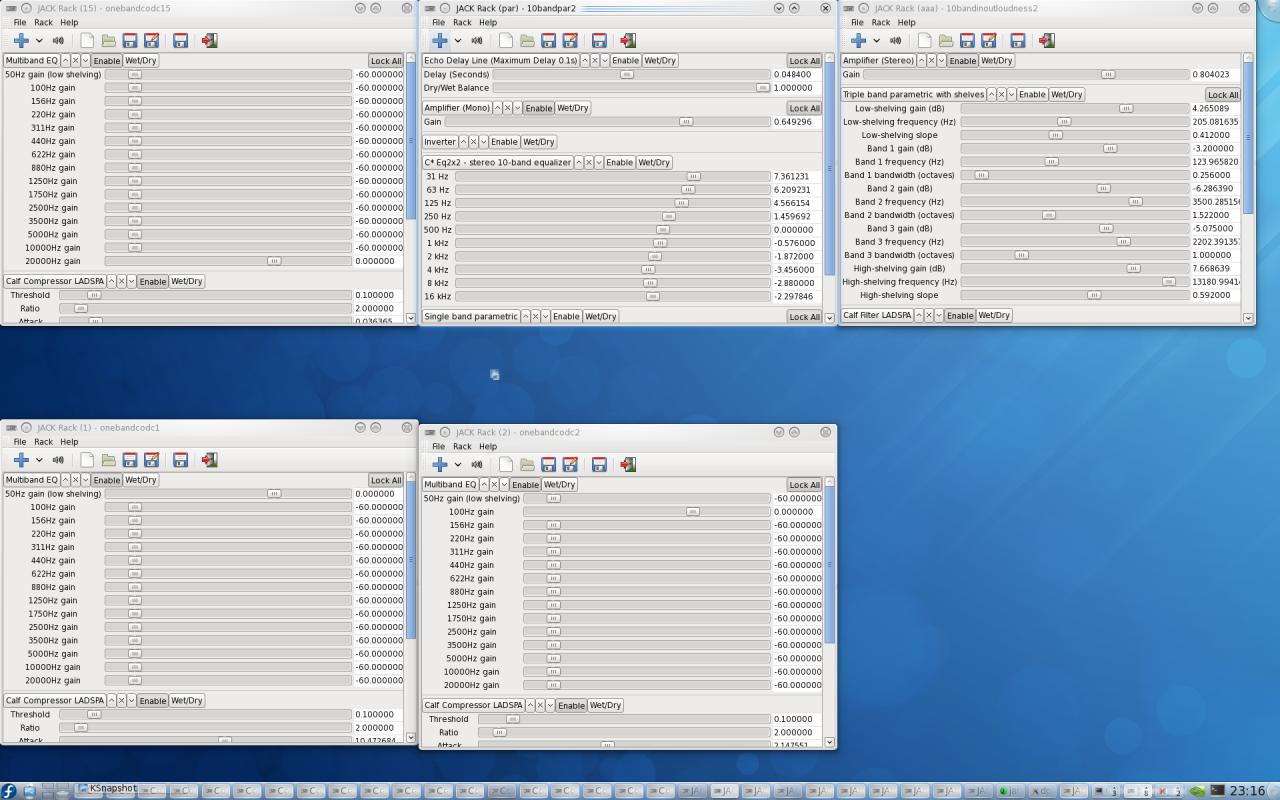
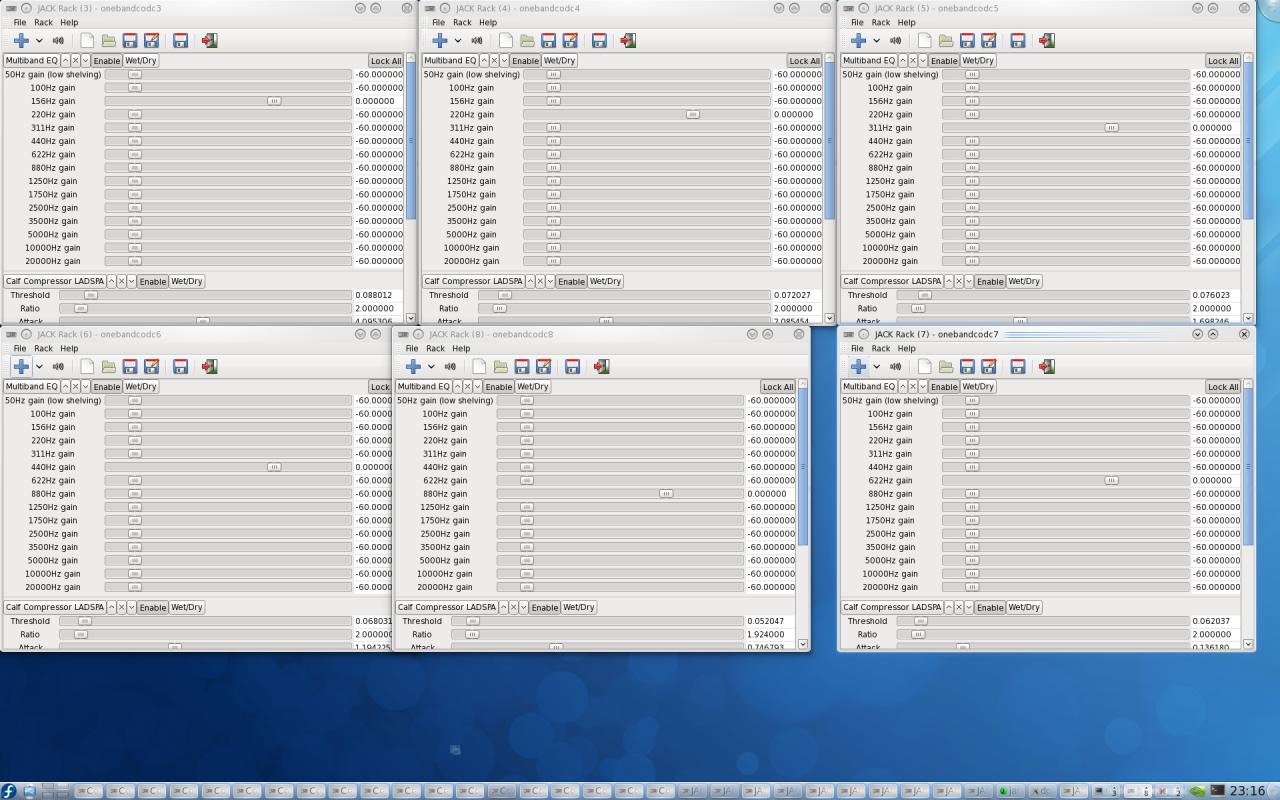
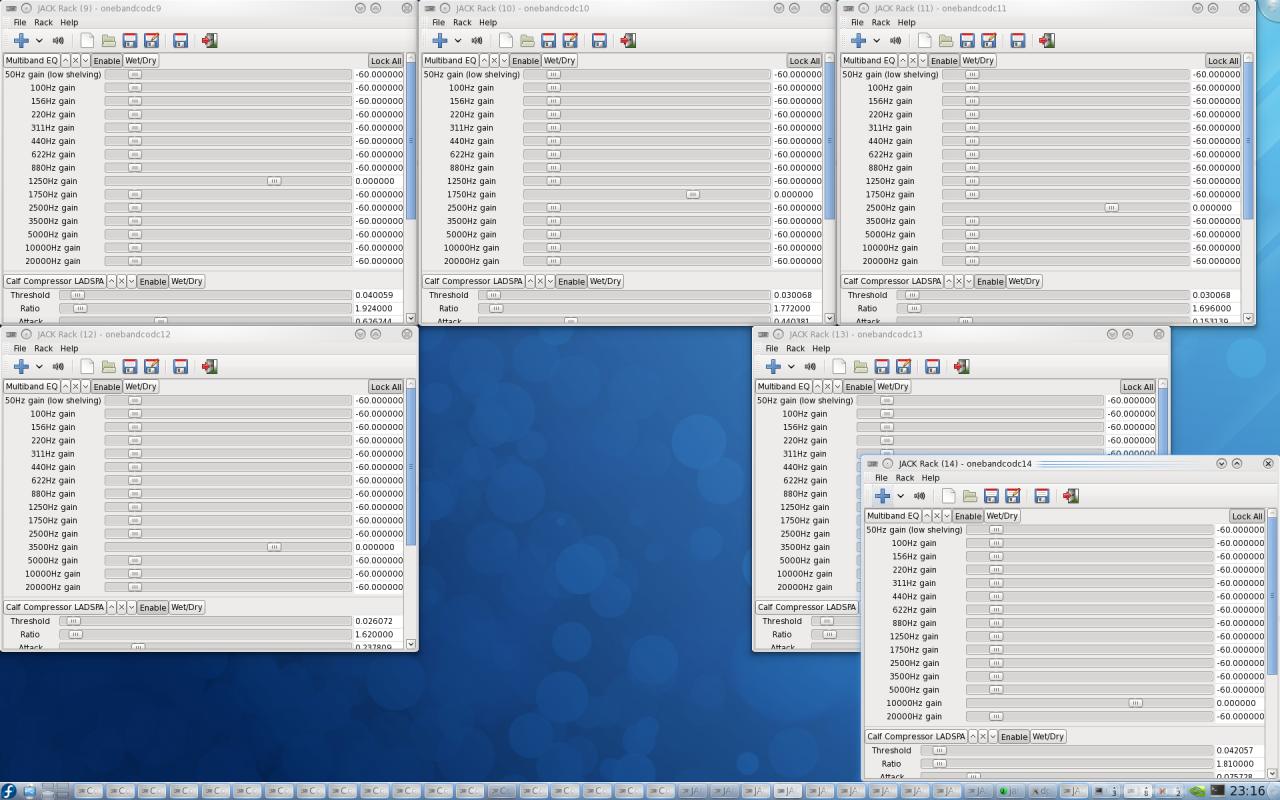
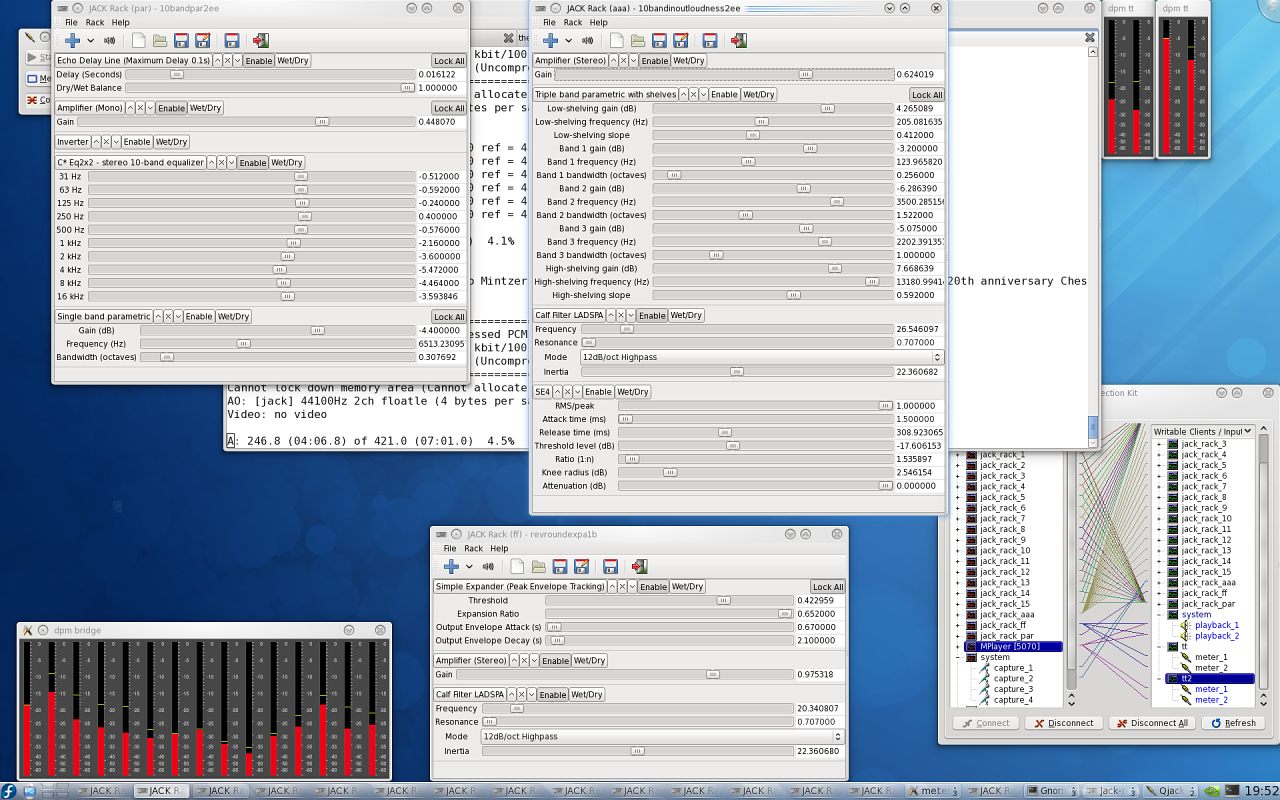
The Lexicon MX400 (which is a double and surround effect with 2 stereo
in and outputs, also able to do 4 effects simultaneously), digitally
coupled, agrees very very well with these sort of signal chains, and
appeats happy and well able to do its magic anywhere in these signal
paths.
In fact I even experimented with a gated feedback loop with the Lexicon
and the multicompression in
the loop, applied to early Elvis recordings and the very good "Last Man
Standing" CD from Jerry Lee Lewis, which with the right settings (even
close to feedback of the loop, and sometimes unstable because of the
combined gate/compression) can get me those mesmerizing Lexicon and
live effects I want, and even fill a neutrally recorded Cheskey track
with great ambiance, of the grand kind. I´ve also added 3
different reverbs, additional filtering, and allpass filtering, which
is great with the tube "feedback" sound.
More on this later, I´ll make some examples.
Harmonisation
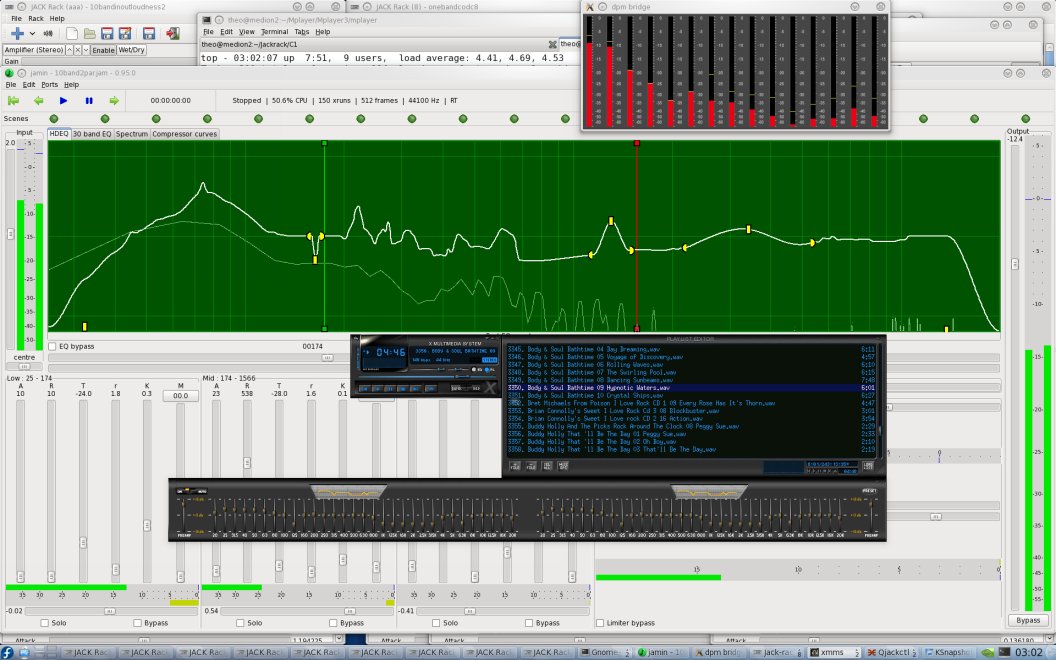
An equalisation with connected multiband compression tuned somewhat to
the components in a E chord.
This effect has side effects, so I often use it in parallel with a
delay line mixed wit the result coming from the same source, set to the
average delay of the effect (tuned with the "jet engine" sound when a
broad spectrum sound is used set to maximally audible high frequencies
and least profound and most symmetrical group delay based
comb-filtering).
Want to see Bond, James Bond movies?
I think I got the majority of them in High Definition quality (with the
actual HD logo, not jut good quality) from the satellite
receiver-computer I use, courtesy of the british ITV.
Is that hard to watch, HD? I do it a hard enough way, with a computer
with originally just a sat receiver but with fast enough interface to
read a whole sat stream with all substreams, a graphics card double
h264 accelerator, Linux, and mplayer, and a lot of controls for
colours, optimisations for VDPAU and such.
I recently tried how long it took me to download, configure, compile,
and test-run a completely fresh mplayer from the source repository, on
the Fedora 12/64 Caviar green 1+1.5 TeraByte, Pentium D, sat
receiver, NVidia Cuda capable 9500 graphics card Linux machine I use
every day for watching TV (and more): 16 minutes!

Cool. And it works in practice, and some good films already.
Databases
I tried the almost latest posgresql and it works, and so does the
latest media wiki, but this is tryout, not on the server machine.
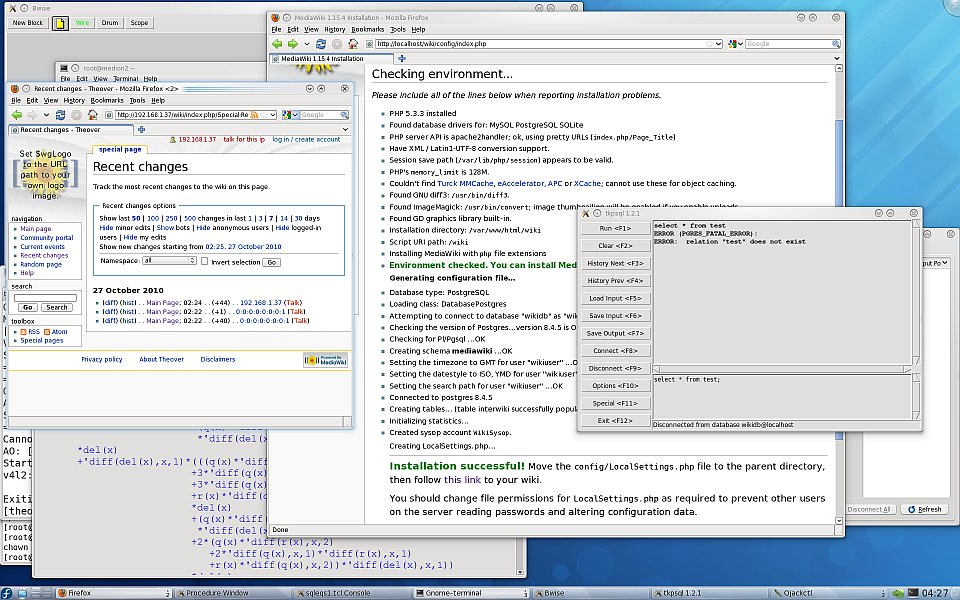
I tried this too.
A new domain name provider
From now on, the cool www.theover.org remains visible in the address
bar of the browser when you click links: no more ip address numbers.
Also there another server on theover.org (no www.) where I can store
files up to a gigabyte for faster download than the www.theover.org
server which I run myself over a ADSL line. Example:
http://theover.org/Video/linuxsound1.mpg
that´s a video I´ve made about linux sound programs
(complicated ones) to use with a streaming 720HD media player.
Can more processing power be bought ?
Lets say an i7 with fermi-capable 2GigaByte graphics card with actual
HD screen, and 4 GB memory and Bluray player and even windows 7, as a
notebook:
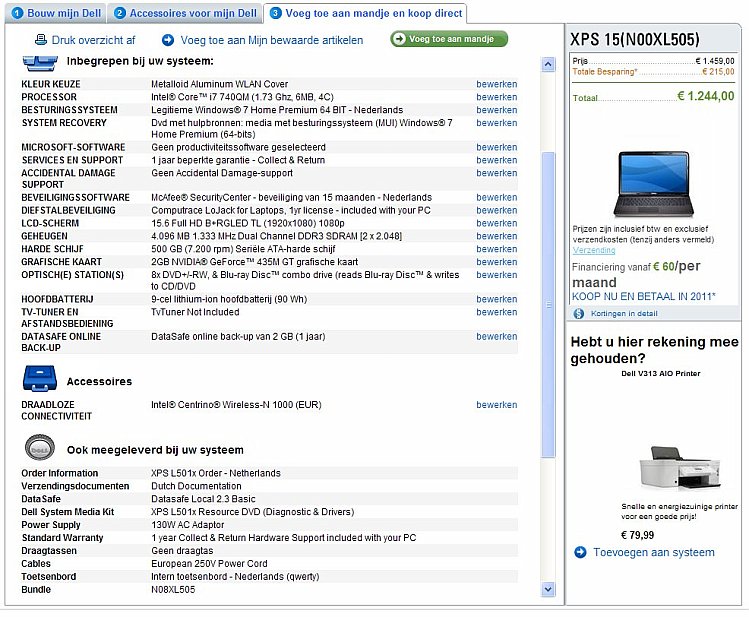
well well...
















